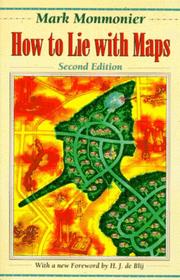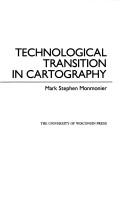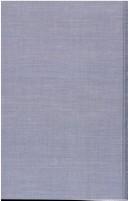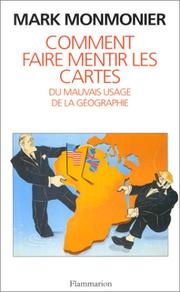| Listing 1 - 8 of 8 |
Sort by
|

ISBN: 0226534200 0226534219 Year: 1996 Publisher: Chicago (Ill.) University of Chicago Press
Abstract | Keywords | Export | Availability | Bookmark
 Loading...
Loading...Choose an application
- Reference Manager
- EndNote
- RefWorks (Direct export to RefWorks)
Originally published to wide acclaim, this illustrated essay on the use and abuse of maps teaches us how to evaluate maps critically and promotes a healthy skepticism about these easy-to-manipulate models of reality. To show how maps distort, Monmonier introduces basic principles of mapmaking, gives entertaining examples of the misuse of maps in situations from zoning disputes to census reports, and covers all the typical kinds of distortions from deliberate oversimplifications to the misleading use of color.
Cartography. --- Deception. --- Geodesy. Cartography --- Maps --- Cartography --- Deception --- Cartes --- Cartographie --- Tromperie --- Analysis --- Analyse --- Aardrijkskunde --- Manipulatie --- Beïnvloeding --- Cartografie --- 528.22 --- 528.9 --- 528.22 Methods of determining the figure of the Earth --- Methods of determining the figure of the Earth --- Chicanery --- Deceit --- Subterfuge --- Truthfulness and falsehood --- Intrigue --- 528.9 Cartography. Mapping (textual documents) --- Cartography. Mapping (textual documents) --- Cartography, Primitive --- Chartography --- Map-making --- Mapmaking --- Mapping (Cartography) --- Mathematical geography --- Surveying --- Map projection

ISBN: 0299100707 Year: 1985 Publisher: Madison, Wis.
Abstract | Keywords | Export | Availability | Bookmark
 Loading...
Loading...Choose an application
- Reference Manager
- EndNote
- RefWorks (Direct export to RefWorks)

ISBN: 0226534170 0226534162 9780226534176 Year: 1993 Volume: *5 Publisher: Chicago (Ill.): University of Chicago press,
Abstract | Keywords | Export | Availability | Bookmark
 Loading...
Loading...Choose an application
- Reference Manager
- EndNote
- RefWorks (Direct export to RefWorks)
Writers know only too well how long it can take--and how awkward it can be--to describe spatial relationships with words alone. And while a map might not always be worth a thousand words, a good one can help writers communicate an argument or explanation clearly, succinctly, and effectively. In his acclaimed 'How to Lie with Maps,' Mark Monmonier showed how maps can distort facts. In 'Mapping it Out: Expository Cartography for the Humanities and Social Sciences,' he shows authors and scholars how they can use expository cartography--the visual, two-dimensional organization of information--to heighten the impact of their books and articles. This concise, practical book is an introduction to the fundamental principles of graphic logic and design, from the basics of scale to the complex mapping of movement or change. Monmonier helps writers and researchers decide when maps are most useful and what formats work best in a wide range of subject areas, from literary criticism to sociology. He demonstrates, for example, various techniques for representing changes and patternsdifferent typefaces and how they can either clarify or confuse informationand the effectiveness of less traditional map forms, such as visibility base maps, frame-rectangle symbols, and complementary scatterplot designs for conveying complex spatial relationships. There is also a wealth of practical information on map compilation, cartobibliographies, copyright and permissions, facsimile reproduction, and the evaluation of source materials. Appendixes discuss the benefits and limitations of electronic graphics and pen-and-ink drafting, and how to work with a cartographic illustrator. Clearly written, and filled with real-world examples, 'Mapping it Out' demystifies mapmaking for anyone writing in the humanities and social sciences. "A useful guide to a subject most people probably take too much for granted. It shows how map makers translate abstract data into eye-catching cartograms, as they are
Cartografie --- Cartographie --- Cartography --- Cartography [Primitive ] --- Chartography --- Mapping (Cartography) --- 528 --- 655.28.026 --- 528.9 --- Geodesy. Surveying. Photogrammetry. Cartography --- Zetten van specifiek drukwerk. Krantzetten. Zetten van commercieel drukwerk. Zetten van postzegels --- Cartography. Mapping (textual documents) --- Cartography. --- Humanities --- Social sciences --- Geografie --- Graphic methods. --- Algemeen. --- 528.9 Cartography. Mapping (textual documents) --- 528 Geodesy. Surveying. Photogrammetry. Cartography --- Behavioral sciences --- Human sciences --- Sciences, Social --- Social science --- Social studies --- Civilization --- Learning and scholarship --- Classical education --- Cartography, Primitive --- Map-making --- Mapmaking --- Mathematical geography --- Surveying --- Map projection --- Maps --- Graphic methods --- Humanities - Graphic methods --- Social sciences - Graphic methods
Book
ISBN: 0131653083 9780131653085 Year: 1982 Publisher: Englewood Cliffs (NJ): Prentice Hall,
Abstract | Keywords | Export | Availability | Bookmark
 Loading...
Loading...Choose an application
- Reference Manager
- EndNote
- RefWorks (Direct export to RefWorks)

ISBN: 2082115577 9782082115575 Year: 1993 Publisher: Paris: Flammarion,
Abstract | Keywords | Export | Availability | Bookmark
 Loading...
Loading...Choose an application
- Reference Manager
- EndNote
- RefWorks (Direct export to RefWorks)
Bedriegerij --- Bedrog --- Cartografie --- Cartographie --- Cartography --- Cartography [Primitive ] --- Chartography --- Chicanery --- Deceit --- Deception --- Listen --- Mapping (Cartography) --- Misleiding --- Ruses --- Subterfuge --- Tromperie --- Maps --- Cartes --- Analysis --- Analyse --- Cartographie. --- Tromperie. --- Cartes geographiques
Book
ISBN: 9780226534688 9780226534671 0226534677 0226534685 Year: 2010 Publisher: Chicago ; London University of Chicago Press
Abstract | Keywords | Export | Availability | Bookmark
 Loading...
Loading...Choose an application
- Reference Manager
- EndNote
- RefWorks (Direct export to RefWorks)
Some maps help us find our way; others restrict where we go and what we do. These maps control behavior. This restrictive cartography has boomed in recent decades as governments seek regulate activities. It is this aspect of mapping —its power to prohibit— that Mark Monmonier tackles in No Dig, No Fly, No Go. Tracing the power of prohibitive mapping at multiple levels —from regional to international— and multiple dimensions —from property to cyberspace— Monmonier demonstrates how much boundaries influence our experience —from homeownership and voting to taxation and airline travel.
Cartography --- Maps --- Social aspects. --- Economic aspects. --- Political aspects. --- 32.019.51 --- 912 --- Massacommunicatie. Opinievorming. Politieke beinvloeding. Politieke manipulatie. Propaganda --- Cartografie. Kaarten. Plattegronden. Atlassen --- 32.019.51 Massacommunicatie. Opinievorming. Politieke beinvloeding. Politieke manipulatie. Propaganda --- Plans --- Cartographic materials --- Geography --- Cartography, Primitive --- Chartography --- Map-making --- Mapmaking --- Mapping (Cartography) --- Mathematical geography --- Surveying --- Map projection --- Economic aspects --- Political aspects --- Social aspects
Book
ISBN: 9780226435923 022643592X Year: 2018 Publisher: Chicago London University of Chicago Press
Abstract | Keywords | Export | Availability | Bookmark
 Loading...
Loading...Choose an application
- Reference Manager
- EndNote
- RefWorks (Direct export to RefWorks)
An instant classic when first published in 1991, How to Lie with Maps revealed how the choices mapmakers make—consciously or unconsciously—mean that every map inevitably presents only one of many possible stories about the places it depicts. The principles Mark Monmonier outlined back then remain true today, despite significant technological changes in the making and use of maps. The introduction and spread of digital maps and mapping software, however, have added new wrinkles to the ever-evolving landscape of modern mapmaking. Fully updated for the digital age, this new edition of How to Lie with Maps examines the myriad ways that technology offers new opportunities for cartographic mischief, deception, and propaganda. While retaining the same brevity, range, and humor as its predecessors, this third edition includes significant updates throughout as well as new chapters on image maps, prohibitive cartography, and online maps. It also includes an expanded section of color images and an updated list of sources for further reading.
Cartography. --- Cartographie. --- Deception. --- Tromperie. --- CARTOGRAPHY
Book
ISBN: 9782746751125 2746751127 Year: 2019 Publisher: Paris: Autrement,
Abstract | Keywords | Export | Availability | Bookmark
 Loading...
Loading...Choose an application
- Reference Manager
- EndNote
- RefWorks (Direct export to RefWorks)
Toutes les cartes, projections sur le papier d'éléments d'un monde en plusieurs dimensions, sont une déformation de la réalité, jusqu'à la rendre parfois fausse. Pour le dire autrement, les cartes nous mentent ! La projection choisie, la simplification cartographique, le choix des échelles, des couleurs ou des figurés, la mise en avant d'un point particulier participent au «mensonge», volontairement ou non. Cette distorsion de la réalité se retrouve dans tous les domaines qui utilisent la cartographie : l'aménagement du territoire, la communication,la publicité, et bien sûr la propagande. S'appuyant sur plus de 120 cartes et documents, cet ouvrage présente des exemples précis et variés : cartes topographiques, cartes géopolitiques, plans de promoteurs immobiliers... Cet ouvrage de référence a été entièrement revu et enrichi pour cette nouvelle édition de chapitres consacrés aux cartes numériques - images satellitaires et cartographie en ligne. L'auteur analyse les enjeux de la cartographie et ouvre ainsi la réflexion pour nous aider à décoder les cartes qui se multiplient dans notre quotidien, via les médias et les réseaux
Cartographie --- Tromperie --- Cartography --- Deception --- Désinformation. --- Disinformation. --- Perception géographique. --- Geographical perception. --- Aspect politique. --- Political aspects. --- Désinformation. --- Perception géographique.
| Listing 1 - 8 of 8 |
Sort by
|

 Search
Search Feedback
Feedback About UniCat
About UniCat  Help
Help News
News